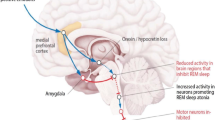Abstract
Background
There are increasing data suggesting the involvement of the immune system in narcolepsy. The co-occurrence of narcolepsy with other autoimmune disorders (including multiple sclerosis, MS) is rare.
Patients and methods
International multicenter sleep center survey and literature review on narcolepsy with (NC) and without (NwC) cataplexy.
Results
A total of 26 patients (pts), 6 in the survey and 20 in the literature were found. Two different types of association were identified: (1) Symptomatic type (5 pts): MS preceding the onset of narcolepsy, which was always without cataplexy (NwC); sleep onset REM episodes (SOREM) and hypocretin deficiency were observed in some, and lesions in the hypothalamus in all patients. (2) Coexisting type (18 pts): MS preceding or following the appearance of NC with SOREM, hypocretin deficiency but no lesions in the hypothalamus. A positive effect of steroids, immunoglobulins or natalizumab on narcolepsy symptoms was observed in four patients.
Discussion
Narcolepsy and MS are rarely associated. In addition to NwC secondary to hypothalamic demyelination, some patients present a coexistence of MS with NC without detectable hypothalamic lesions. The rarity of reports on this association probably reflects underrecognition. The elucidation of underlying genetic and immune mechanisms needs further studies.
Similar content being viewed by others
References
Hublin C, Kaprio J, Partinen M, Koskenvuo M, Heikkila K, Koskimies S, Guilleminault C (1994) The prevalence of narcolepsy: an epidemiological study of the finnish twin cohort. Ann Neurol 35:709–716
Silber MH, Krahn LE, Olson EJ, Pankratz VS (2002) The epidemiology of narcolepsy in Olmsted County, Minnesota: a population-based study. Sleep 25:197–202
Goldbart A, Peppard P, Finn L, Ruoff CM, Barnet J, Young T, Mignot E (2014) Narcolepsy and predictors of positive MSLTs in the Wisconsin Sleep Cohort. Sleep 37:1043–1051
Liblau RS, Vassalli A, Seifi A, Tafti M (2015) Hypocretin (orexin) biology and the pathophysiology of narcolepsy with cataplexy. Lancet Neurol 14:318–328
Andlauer O, Moore H IV, Hong SC et al (2012) Predictors of hypocretin (orexin) deficiency in narcolepsy without cataplexy. Sleep 35:1247–1255
Bernard-Valnet R, Yshii L, Quériault C et al (2016) CD8 T cell-mediated killing of orexinergic neurons induces a narcolepsy-like phenotype in mice. Proc Natl Acad Sci USA 113:10956–10961
Kamm CP, Uitdehaag BM, Polman CH (2014) Multiple sclerosis: current knowledge and future outlook. Eur Neurol 72:132–141
Schmidt H, Williamson D, Ashley-Koch A (2007) HLA-DR15 haplotype and multiple sclerosis: a HuGE review. Am J Epidemiol 165:1097–1109
Brass SD, Li CS, Auerbach S (2014) The underdiagnosis of sleep disorders in patients with multiple sclerosis. J Clin Sleep Med 10:1025–1031
Barateau L, Lopez R, Arnulf I et al (2017) Comorbidity between central disorders of hypersomnolence and immune-based disorders. Neurology 88:93–100
Nishino S, Kanbayashi T (2005) Symptomatic narcolepsy, cataplexy and hypersomnia, and their implications in the hypothalamic hypocretin/orexin system. Sleep Med Rev 9:269–310
Silber MH (2016) Autoimmune sleep disorders. Handb Clin Neurol 133:317–326
Ekbom K (1966) Familial multiple sclerosis associated with narcolepsy. Arch Neurol 15:337–344
Lorenzoni PJ, Werneck LC, Crippa AC et al (2017) Is there a relationship between narcolepsy, multiple sclerosis and HLA-DQB1*06:02? Arq Neuropsiquiatr 75:345–348
Jennum PJ, Kornum BR, Issa NM,et al (2016) Monozygotic twins discordant for narcolepsy type 1 and multiple sclerosis. Neurol Neuroimmunol Neuroinflamm 3:e249
Hor H, Kutalik Z, Dauvilliers Y et al (2010) Genome-wide association study identifies new HLA class II haplotypes strongly protective against narcolepsy. Nat Genet 42:786–789
Moutsianas L, Jostins L, Beecham AH et al (2015) Class II HLA interactions modulate genetic risk for multiple sclerosis. Nat Genet 47:1107–1113
Zivadinov R, Uxa L, Bratina A et al (2007) HLA-DRB1*1501,-DQB1*0301,-DQB1*0302, -DQB1*0602, and -DQB1*0603 alleles are associated with more severe disease outcome on MRI in patients with Multiple Sclerosis. Int Rev Neurobiol 79:521–535
Tafti M, Hor H, Dauvilliers Y, Lammers GJ, Overeem S, Mayer G (2014) DQB1 locus alone explains most of the risk and protection in narcolepsy with cataplexy in Europe. Sleep 37:19–25
Zandian A, Forsström B, Häggmark-Månberg A et al (2017) Whole-proteome peptide microarrays for profiling autoantibody repertoires within multiple sclerosis and narcolepsy. J Proteome Res 16:1300–1314
Zabad RK, Stewart R, Healey KM (2017) Pattern recognition of the multiple sclerosis syndrome. Brain Sci 7:E138
Hor H, Bartesaghi L, Kutalik Z et al (2011) A missense mutation in myelin oligodendrocyte glycoprotein as a cause of familial narcolepsy with cataplexy. Am J Hum Genet 89:474–479
Latorre D, Kallweit U, Armentani E et al. Autoreactive T cells in narcolepsy patients target antigens of hypocretin-producing neurons (Review)
Penner I-K, Sivertsdotter EC, Celius EG et al (2015) Improvement in fatigue during natalizumab treatment is linked to improvement in depression and day-time sleepiness. Front Neurol 6:18
Sater RA, Gudesblatt M, Kresa-Reahl K, Brandes DW, Sater P (2016) NAPS-MS: natalizumab effects on parameters of sleep in patients with multiple sclerosis. Int J MS Care 18:177–182
Author information
Authors and Affiliations
Corresponding author
Ethics declarations
Conflict of interest
The authors declare that they have no conflict of interest.
Rights and permissions
About this article
Cite this article
Kallweit, U., Bassetti, C.L.A., Oberholzer, M. et al. Coexisting narcolepsy (with and without cataplexy) and multiple sclerosis. J Neurol 265, 2071–2078 (2018). https://doi.org/10.1007/s00415-018-8949-x
Received:
Revised:
Accepted:
Published:
Issue Date:
DOI: https://doi.org/10.1007/s00415-018-8949-x




